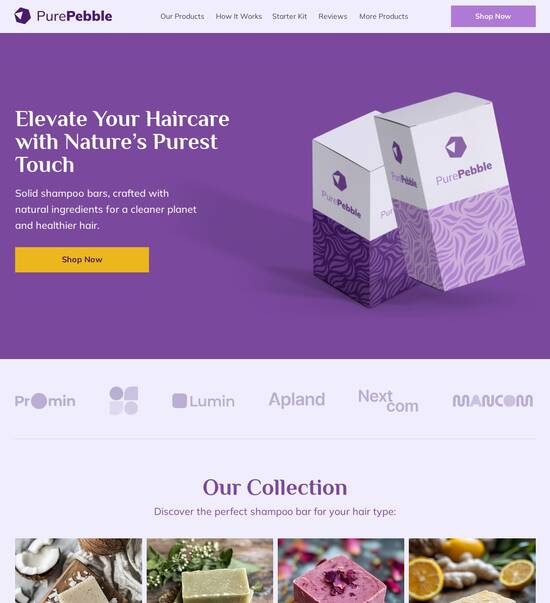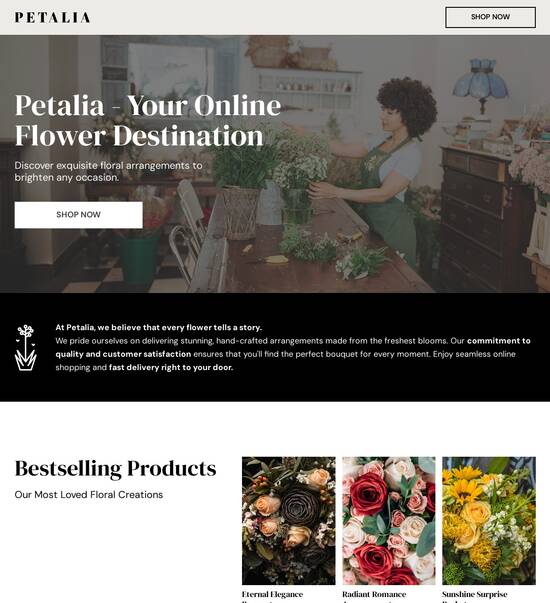
Grid-based seller page template
Explore Similar TemplatesAbout template
Unleash your creativity with the grid-based seller page template. Try Instapage today.
Recommended templates

Easy to build without coding
With the intuitive drag-and-drop builder, anyone on your team can create high-converting pages without any knowledge of code or design. Make enhancements to your landing page with custom widgets using Javascript, HTML/CSS, or third-party scripts.

Multiple layouts for any industry and goal
Select from 500+ landing page layouts built to boost conversions across industry-specific scenarios. Customize them by adjusting fonts, adding images, and generating on-brand content with the AI assistant. Quickly scale with Instablocks® and Global Blocks that you can save, reuse, and update globally.

Loads fast and looks polished on any device
Every template is responsive, which means they present professionally on any device and load blazingly fast with our Thor Render Engine. You can also power them up with Google AMP technology to deliver an unparalleled mobile experience and drive higher conversions.

Robust analytics & experimentation
Get real-time updates and reporting across all your devices, showing the number of visitors, conversions, cost-per-visitor, and cost-per-lead. Launch AI-powered experiments, run A/B tests, and use heatmaps to analyze user behavior, then optimize your landing page to maximize conversions.







Easy to build without coding
With the intuitive drag-and-drop builder, anyone on your team can create high-converting pages without any knowledge of code or design. Make enhancements to your landing page with custom widgets using Javascript, HTML/CSS, or third-party scripts.
Multiple layouts for any industry and goal
Select from 500+ landing page layouts built to boost conversions across industry-specific scenarios. Customize them by adjusting fonts, adding images, and generating on-brand content with the AI assistant. Quickly scale with Instablocks® and Global Blocks that you can save, reuse, and update globally.
Loads fast and looks polished on any device
Every template is responsive, which means they present professionally on any device and load blazingly fast with our Thor Render Engine.
Robust analytics & experimentation
Get real-time updates and reporting across all your devices, showing the number of visitors, conversions, cost-per-visitor, and cost-per-lead. Launch AI-powered experiments, run A/B tests, and use heatmaps to analyze user behavior, then optimize your landing page to maximize conversions.
All the features you need to build lead-generating landing pages
Explore more featuresLearn how to build top-performing landing pages for any goal
FAQs
Leading the way in building high-performing landing pages





Unlocking conversion potential with Instapage landing pages
Effective landing pages are crucial for maximizing online marketing efforts, helping businesses capture leads and drive conversions. Instapage offers a powerful solution tailored specifically for marketers across various industries such as tech, education, and financial services. With its extensive features and user-friendly interface, Instapage enables you to optimize and personalize your campaigns seamlessly.
Why use Instapage for landing page creation?
Instapage stands out with its all-in-one approach to landing page creation and conversion rate optimization (CRO). The platform provides an array of customizable templates that cater to diverse business needs, allowing even those without coding skills to create visually appealing and effective landing pages.
- Access to over 100 high-converting templates: These templates can be customized to fit your branding, ensuring consistency and enhancing user experience.
- Built-in A/B testing tools: Experiment with different page designs and content to discover what resonates most with your target audience, driving higher conversions.
- Comprehensive analytics dashboard: Track performance metrics in real-time, allowing quick adjustments to maximize ROI.
Step 1: Choose the right template
Selecting an appropriate template is fundamental to your landing page's success. Consider the nature of your campaign and your audience's preferences. Instapage's library provides templates ranging from simple forms to complex multi-step landing pages.
Step 2: Customize your landing page
Customization allows your landing page to stand out. Utilize Instablocks for easy layouts and dynamic text replacement for personalization.
- Incorporate brand colors and fonts: Ensure your landing page aligns with your branding for a cohesive look.
- Add compelling visuals: High-quality images or videos can engage visitors and communicate your message effectively.
- Utilize lead generation elements: Forms, buttons, and calls to action should be strategically placed to facilitate user engagement.
Step 3: Optimize for conversions
Once your page is live, the work isn’t over. Use Instapage’s optimization features, such as heatmaps and A/B testing, to refine your page further.
- Analyze heatmaps: Understand where users are clicking and spending time, allowing you to fine-tune your design for better engagement.
- Conduct A/B tests: Test variations of your headlines, images, and calls-to-action to determine the most effective combinations.
- Review performance metrics: Monitor and assess your landing page's performance to continuously optimize for improved results.
Instapage empowers marketers to create efficient landing pages that drive conversions through their innovative tools and features. The combination of flexibility, user-friendly design, and powerful analytics ensures your marketing campaigns succeed.
Ready to elevate your digital marketing strategy? Discover how Instapage can transform your landing pages today and start maximizing your ROI.
Grid-based seller page templates: Enhancing eCommerce experiences
Understanding grid-based seller page templates
Grid-based seller page templates have become essential tools for eCommerce websites, allowing marketers to create visually appealing and organized layouts. These templates leverage a structured grid system to present products and services attractively. By organizing elements in a systematic way, grid designs enhance user experience while promoting brand identity and driving conversions.
The evolution of web design: From static pages to dynamic grids
Historically, web design began with static pages that provided limited interactivity and cluttered layouts. With the advent of web 2.0, designers embraced dynamic layouts to create richer user experiences. The introduction of responsive design has further transformed how we perceive web layouts. As more users accessed the internet through mobile devices, the need for flexible structures rose.
Adopting a grid-based approach helps to optimize visual aesthetics and usability. It allows designers to maintain a sense of order amidst varying screen sizes, enhancing functionality across devices. Marketers and designers alike are recognizing the benefits of grids, such as improved clarity and enhanced user engagement.
Grid-based templates: An overview
Grid-based seller page templates serve as key frameworks that dictate how products and services are organized on a page. These templates create a consistent and easily navigable layout by using rows and columns to structure content. When properly designed, grid systems enhance visual hierarchy, guiding users' attention to critical areas like product images, prices, and call-to-action buttons.
Successful grid templates are user-centered, aesthetically pleasing, and provide instant access to essential information. They also contribute to a better user experience, encouraging increased interaction and helping to maximize conversion rates. Grid structures not only organize content but also establish a rhythm that supports seamless navigation.
Crafting the perfect grid: Structural composition
Understanding the anatomy of grid structures is crucial for creating effective templates. Grids typically consist of a series of columns and rows that establish a modular design framework. The placement of content within this structure should consider aspect ratios and spacing to ensure that every element is visually balanced.
When optimizing layout for various content types, it's vital to prioritize whitespace to avoid clutter. This allows visitors to focus on the key aspects of your offering. Best practices include using a responsive layout, maintaining consistency in sizing and positioning, and ensuring alignment is clear. Each content type—from images to text boxes—should fit harmoniously within the grid.
Enhanced user experience through grid design
Grid templates play a pivotal role in improving usability and navigation. By creating a predictable pattern for users to follow, grids make it easier for them to locate information quickly. The visual appeal of well-structured grids tends to hold attention longer, providing an immersive experience that encourages exploration.
The psychology of layouts suggests that users respond positively to organized information. Research has shown that visitors are more likely to engage with pages that employ a clear visual hierarchy, thus resulting in better retention rates. Case studies demonstrate significant improvements in website interactions and conversions when employing grid-based designs.
Customizing grid templates: The developer’s playground
Grid-based templates are only as good as their implementation, and customization allows developers to maximize potential. Various tools and platforms cater to customization, including popular website builders and design software. Developers can enhance the functionality of grid layouts by employing CSS and JavaScript to create unique interactions and visual styles.
Adopting responsive design practices is essential to ensure that grid templates function well across all devices. Techniques such as media queries can adjust elements based on screen sizes, providing optimal experiences whether users are on desktop or mobile. Custom grid templates can also be A/B tested for performance improvements, tailoring the user experience to better meet audience expectations.
Themes that resonate: Tailoring content to visitor needs
Selecting the right theme compatible with grid-based layouts is key to creating a cohesive online presence. Your template should not only reflect your brand identity but also resonate with the audience's preferences. This alignment ensures that visitors have a unified experience from first interaction to final conversion.
Identify your target audience preferences.
Choose a theme that reflects your brand’s core values.
Incorporate visuals that resonate with the intended demographic.
Successful examples of grid-based themes used in eCommerce showcase adaptability to different market needs. Brands that story-driven visuals combined with effective grid layouts can create engaging experiences that guide customers through the sales funnel.
Functionality meets aesthetics: Balancing design with purpose
In grid-based seller page templates, functionality must work hand-in-hand with aesthetics to drive conversions. Essential functions, like clear navigation and easy-to-find products, support user journeys while offering a pleasing visual experience. The integration of multimedia elements—such as high-quality images and videos—further enhances engagement.
An effective grid layout incorporates forms and calls to action intuitively. Positioning these elements strategically within the grid draws attention without overwhelming the user. This thoughtful balance between functionality and design is vital to converting visitors into customers.
Solutions for diverse industries: One template fits all?
The beauty of grid templates lies in their versatility across various industries. From real estate listings to retail product showcasing, grid designs serve distinct needs while maintaining a user-friendly interface. Each sector can benefit from customized solutions that cater specifically to their audiences and product types.
Retail: Highlighting product categories effectively.
Real Estate: Organizing listings by property type and location.
Education: Structuring course offerings for easy access.
Analyzing results from case studies reveals impressive metrics. Brands that have implemented tailored grid templates often report increased page visits and higher conversion rates, demonstrating the effectiveness of this approach.
Measuring results: Analytics and grid template performance
To ensure grid templates are yielding desired results, employing analytics tools is crucial. Monitoring visitor engagement metrics offers insights into user behavior. Understanding how visitors interact with different elements helps marketers fine-tune their strategies.
Additionally, A/B testing various grid layout variations can reveal what works best from a conversion standpoint. Upholding a data-driven approach ensures design decisions resonate with user needs, ultimately driving better outcomes for businesses utilizing grid templates.
Future trends in grid-based web design
Emerging technologies are set to reshape grid systems and online experiences. As the need for accessibility and inclusivity grows, grid designs will increasingly focus on accommodating diverse user groups. Moreover, advancements in artificial intelligence can personalize the browsing experience by recommending products based on user behavior.
In the coming years, grid designs will likely evolve alongside user expectations. Brands that prioritize innovation in their layouts and remain aware of shifting trends will position themselves favorably within the competitive digital landscape.
Real-world applications: Businesses thriving with grid templates
Practical implementation examples can illustrate the transformative effect of grid-based templates on businesses. Developers and entrepreneurs who have leveraged grid design share compelling insights into their journey and the tangible results observed.
Success stories highlight how unique implementations have led to improved user experiences and increased sales. Conversely, reflections on design failures provide valuable lessons, emphasizing the importance of user feedback and ongoing optimization.
Creating interactive and dynamic grids
Incorporating interactive features into grid designs enhances user engagement significantly. Elements such as animations, hover effects, and dynamic content can create a more immersive experience. These features grab users' attention, encouraging them to explore the site further.
The impact of interactivity on visitor retention and conversion rates is notable. Tools and plugins that facilitate grid functionality can streamline the implementation of such features, making it easier for developers to create engaging web pages.
Bridging the gap: Connecting grid templates to broader marketing strategies
Grid templates should not exist in isolation; they need to connect with broader marketing strategies. Effective integration with email marketing campaigns, search engine optimization, and social media efforts can amplify the impact of grid designs. Every digital touchpoint should embody cohesive branding that translates across platforms.
By aligning grid design with overarching marketing initiatives, brands can leverage these templates to articulate their messages consistently and effectively, ensuring that customer experiences remain seamless and engaging throughout the customer journey.
Summary of benefits: A comprehensive look at grid-based seller page templates
Grid layouts have profoundly impacted landing pages by providing clarity and organization. Businesses adopting grid-based templates often reap long-term benefits, including increased conversions and enhanced user experience.
As the digital landscape continues to evolve, staying ahead with innovative web design concepts like grid templates will be essential. Businesses that invest in effective designs can significantly improve customer loyalty, operational efficiency, and overall brand perception.
Ready to skyrocket conversions?
Supercharge your ad campaigns with high-performing landing pages
Get started














